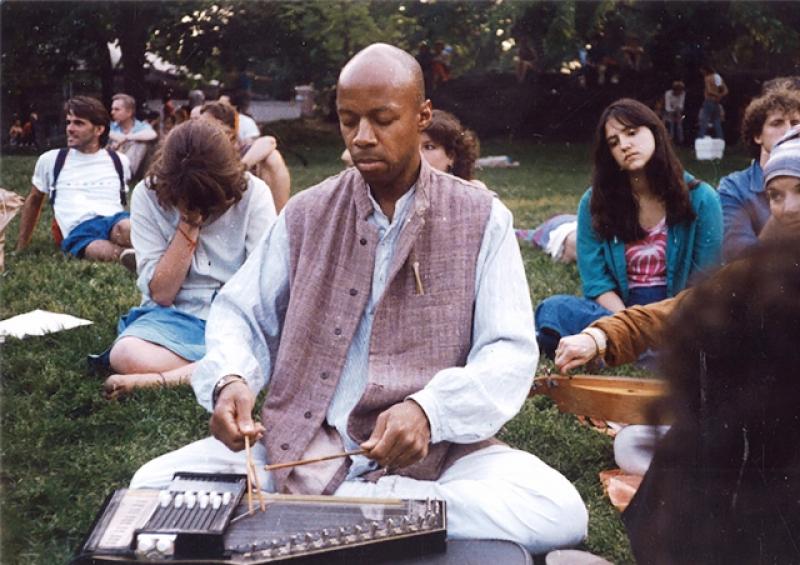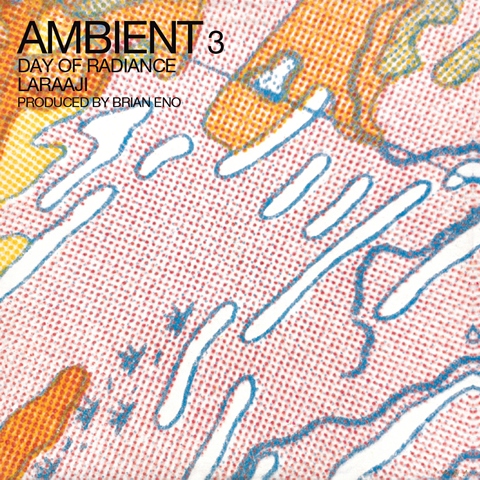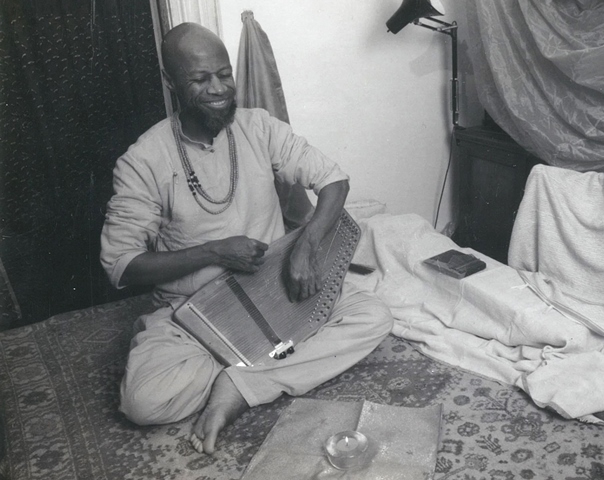Reissue CDs Weekly: Laraaji | reviews, news & interviews
Reissue CDs Weekly: Laraaji
Reissue CDs Weekly: Laraaji
Whether ambient, New Age or neither, 1980’s ‘Day of Radiance’ sounds beautiful

 Laraaji: Ambient 3 – Day of Radiance
Laraaji: Ambient 3 – Day of Radiance
“If you are OK with this as being an ‘ambient’ record, then I am OK with it too,” says Laraaji in the booklet accompanying this new reissue of his first album, 1980's Day of Radiance. He goes on to explain that back then he described his music as “‘beautiful’ or ‘ethereal’ or ‘celestial’.” As for being defined as New Age, he declares: “I have always accepted it. It was a term that was very alive at the time I began exploring this direction.” Minimalism is another genre which Day of Radiance could slot into quite comfortably. Pinning down exactly what Laraaji had done is still problematic.
If the album had been released without the word ambient prefixing its title and minus the sleeve credit “Produced by Brian Eno”, Ambient 3 – Day of Radiance would probably now be thought of as a New Age curio and rarity, to be filed beside albums by, say, Steven Halpern. Instead, it came between 1980’s Ambient 2 (Harold Budd and Brian Eno’s The Plateaux of Mirror) and 1982’s Ambient 3 (Eno’s On Land). The first of the series was Eno’s Ambient 1 – Music for Airports, released in 1978. Ambient it was then for Laraaji.
Day of Radiance was the only Eno-related album made by Laraaji. He has gone on to make around 29 more. Most are self-released and around a quarter are collaborations. He is still active and might not have been so prolific without the Eno connection. In the interview, he offers a simple “Yes” in response to the comment “Eno really helped put you on the map.” Eno may have been claiming or labelling ambient as a genre, but after he moved on, Laraaji continued his pursuit of a music that was as beautiful, celestial or ethereal as possible.
 The first adjective is the operative with Day of Radiance. It truly is beautiful. There are five tracks: “The Dance”, which was split into three parts on side one of the original album; and “Mediation”, which was split into two on side two. Laraaji’s instrument is the zither. The un-damped strings are stuck with hammers, so individual tonal chimes bleed into one another, creating an ever-shimmering cloud of sound. There is a kinship with, as Laraaji notes, Balinese and Javanese gamelan as well Irish-Celtic hammered dulcimer music. There are also clear resonances of the Finnish kantele, the Estonian kanele and related instruments like Japan’s koto, as well as the circular compositions of Philip Glass. The gorgeous Day of Radiance actually could be the aural equivalent to the music of the spheres.
The first adjective is the operative with Day of Radiance. It truly is beautiful. There are five tracks: “The Dance”, which was split into three parts on side one of the original album; and “Mediation”, which was split into two on side two. Laraaji’s instrument is the zither. The un-damped strings are stuck with hammers, so individual tonal chimes bleed into one another, creating an ever-shimmering cloud of sound. There is a kinship with, as Laraaji notes, Balinese and Javanese gamelan as well Irish-Celtic hammered dulcimer music. There are also clear resonances of the Finnish kantele, the Estonian kanele and related instruments like Japan’s koto, as well as the circular compositions of Philip Glass. The gorgeous Day of Radiance actually could be the aural equivalent to the music of the spheres.
Laraaji himself has more Earth-bound origins. He was born Edward Larry Gordon in 1943 (Larry G leads to Laraaji), grew up in New Jersey and studied music at Washington DC’s Howard University in the early Sixties. His main instrument was piano. In 1966, he began working as a stand-up comedian in New York’s Greenwich Village. There, he came across bluegrass musicians playing the autoharp. His interest in it led him to reverse engineer the instrument by removing the chord dampers to make it into a zither. Finding out about hammered dulcimer player Dorothy Carter inspired him to try the same playing technique with both his modified autoharp and the zither.
While playing New York’s Washington Square Park, he recalls being told his music sounded like Fripp & Eno, whose 1975 album Evening Star has a familial relationship with Laraaji’s sound world. Yet he had heard of neither, and had evolved his path on his own. Then, coincidentally and in the same place, a passing Eno left a note saying: “Kindly excuse this impromptu piece of message, I was wondering if you would be interested in talking about participating in a recording project I am doing?” Larajji had not seen anyone leaving it, as he plays with his eyes closed.
The result was Day of Radiance. Disappointingly, this inspiring album is listed on Amazon with the artist credit as Brian Eno. Despite this regrettable blunder, Laraaji’s dazzling creation has to be heard.
Next week: the previously unreleased second album by Levitation
Share this article
The future of Arts Journalism
You can stop theartsdesk.com closing!
We urgently need financing to survive. Our fundraising drive has thus far raised £49,000 but we need to reach £100,000 or we will be forced to close. Please contribute here: https://gofund.me/c3f6033d
And if you can forward this information to anyone who might assist, we’d be grateful.

Subscribe to theartsdesk.com
Thank you for continuing to read our work on theartsdesk.com. For unlimited access to every article in its entirety, including our archive of more than 15,000 pieces, we're asking for £5 per month or £40 per year. We feel it's a very good deal, and hope you do too.
To take a subscription now simply click here.
And if you're looking for that extra gift for a friend or family member, why not treat them to a theartsdesk.com gift subscription?
more New music
 Kali Malone and Drew McDowell generate 'Magnetism' with intergenerational ambience
Young composer and esoteric veteran achieve alchemical reaction in endless reverberations
Kali Malone and Drew McDowell generate 'Magnetism' with intergenerational ambience
Young composer and esoteric veteran achieve alchemical reaction in endless reverberations
 Benson Boone, O2 London review - sequins, spectacle and cheeky charm
Two hours of backwards-somersaults and British accents in a confetti-drenched spectacle
Benson Boone, O2 London review - sequins, spectacle and cheeky charm
Two hours of backwards-somersaults and British accents in a confetti-drenched spectacle
 Midlake's 'A Bridge to Far' is a tour-de-force folk-leaning psychedelic album
The Denton, Texas sextet fashions a career milestone
Midlake's 'A Bridge to Far' is a tour-de-force folk-leaning psychedelic album
The Denton, Texas sextet fashions a career milestone
 'Vicious Delicious' is a tasty, burlesque-rockin' debut from pop hellion Luvcat
Contagious yarns of lust and nightlife adventure from new pop minx
'Vicious Delicious' is a tasty, burlesque-rockin' debut from pop hellion Luvcat
Contagious yarns of lust and nightlife adventure from new pop minx
 Music Reissues Weekly: Hawkwind - Hall of the Mountain Grill
Exhaustive box set dedicated to the album which moved forward from the ‘Space Ritual’ era
Music Reissues Weekly: Hawkwind - Hall of the Mountain Grill
Exhaustive box set dedicated to the album which moved forward from the ‘Space Ritual’ era
 'Everybody Scream': Florence + The Machine's brooding sixth album
Hauntingly beautiful, this is a sombre slow burn, shifting steadily through gradients
'Everybody Scream': Florence + The Machine's brooding sixth album
Hauntingly beautiful, this is a sombre slow burn, shifting steadily through gradients
 Cat Burns finds 'How to Be Human' but maybe not her own sound
A charming and distinctive voice stifled by generic production
Cat Burns finds 'How to Be Human' but maybe not her own sound
A charming and distinctive voice stifled by generic production
 Todd Rundgren, London Palladium review - bold, soul-inclined makeover charms and enthrals
The wizard confirms why he is a true star
Todd Rundgren, London Palladium review - bold, soul-inclined makeover charms and enthrals
The wizard confirms why he is a true star
 It’s back to the beginning for the latest Dylan Bootleg
Eight CDs encompass Dylan’s earliest recordings up to his first major-league concert
It’s back to the beginning for the latest Dylan Bootleg
Eight CDs encompass Dylan’s earliest recordings up to his first major-league concert
 Ireland's Hilary Woods casts a hypnotic spell with 'Night CRIÚ'
The former bassist of the grunge-leaning trio JJ72 embraces the spectral
Ireland's Hilary Woods casts a hypnotic spell with 'Night CRIÚ'
The former bassist of the grunge-leaning trio JJ72 embraces the spectral
 Lily Allen's 'West End Girl' offers a bloody, broken view into the wreckage of her marriage
Singer's return after seven years away from music is autofiction in the brutally raw
Lily Allen's 'West End Girl' offers a bloody, broken view into the wreckage of her marriage
Singer's return after seven years away from music is autofiction in the brutally raw

Add comment